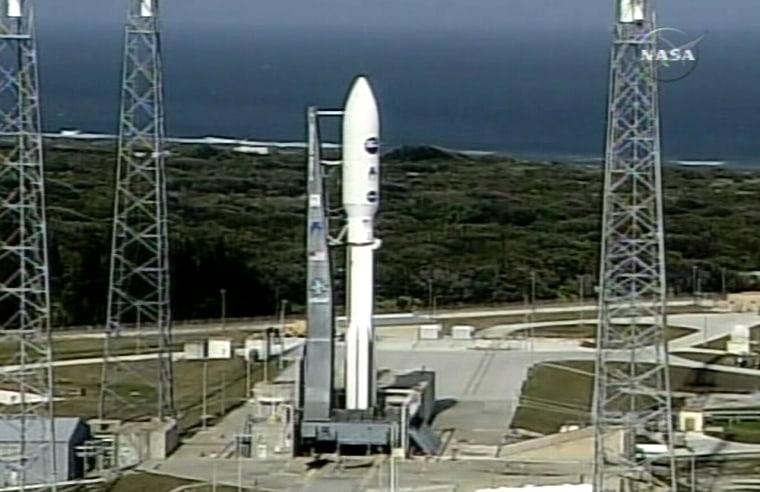For the second day in a row Wednesday, NASA scrubbed the launch of an unmanned spacecraft on a nine-year voyage to Pluto — this time because a storm in Maryland knocked out the power at a laboratory that will operate the probe.
NASA officials planned to make a third attempt to launch the New Horizons probe Thursday after electricity was restored to the lab. Thursday's launch opportunity extends from 1:08 to 3:06 p.m. ET.
High winds at the launch pad kept the spacecraft from lifting off Tuesday, the first day the launch window opened.
Scientists have been working 17 years on the $700 million mission, and they were unfazed by the back-to-back postponements. “Two or three days doesn’t mean a hill of beans,” said Alan Stern, principal investigator for the mission.
A storm in Laurel, Md., knocked out power early Wednesday at the John Hopkins University Applied Physics Laboratory.
“The air conditioning was off. The flight controllers were sitting there wiping sweat,” Stern said. “If they were dealing with any spacecraft issues, which first day out of the box a lot of spacecraft have, you can’t concentrate like that.”
The space agency has until mid-February to launch the piano-sized spacecraft, but a launch in January would allow the spacecraft to use Jupiter’s gravity to shave five years off the 3-billion-mile (4.8-billion-kilometer) trip. If New Horizons doesn't get off the ground by Feb. 14, NASA would have to delay the launch until next year, due to the delicate orbital mechanics involved in the trip.
Last planet to be visited
A successful journey to Pluto would complete an exploration of the planets started by NASA in the early 1960s with unmanned missions to observe Mars, Mercury and Venus.
“What we know about Pluto today could fit on the back of a postage stamp,” said Colleen Hartman, a deputy associate administrator at NASA. “The textbooks will be rewritten after this mission is completed.”
Pluto is the only planet discovered by a U.S. citizen, though some astronomers dispute Pluto’s right to be called a planet. It is an oddball icy dwarf, unlike the rocky planets of Mercury, Venus, Earth and Mars and the gaseous planets of Jupiter, Saturn, Uranus and Neptune.
“My dad would be absolutely thrilled to see this,” said Annette Tombaugh-Sitze, whose father, astronomer Clyde Tombaugh, discovered Pluto in 1930. Members of the Tombaugh family, including Tombaugh’s 93-year-old widow, Patricia, had planned to watch the launch at the Cape Canaveral Air Force Station.
'Fantastic relic'
Pluto is the brightest body in a zone of the solar system known as the Kuiper Belt, made up of thousands of icy, rocky objects, including tiny planets whose development was stunted by unknown causes. Scientists believe studying those “planetary embryos” can help them understand how planets were formed.
“Something, and we don’t understand what ... stopped that process of growth and left us with this fantastic relic, this forensic evidence of planets that were arrested in the midstage of growth,” Stern said.
New Horizons' Atlas 5 launch vehicle is programmed to speed the spacecraft away from Earth at 36,000 mph (57,600 kilometers per hour), the fastest launch speed on record. The craft will reach Earth’s moon in about nine hours and arrive in 13 months at Jupiter, where it will use the giant planet’s gravity as a slingshot, shaving five years off the 3-billion-mile (4.8-billion-kilometer) trip.
The launch preparations drew attention from opponents of nuclear power because the spacecraft is powered by 24 pounds (11 kilograms) of plutonium, whose natural radioactive decay will generate electricity for the probe’s instruments.
A recent protest drew merely 30 anti-nuclear activists, however. In comparison, hundreds protested the 1997 launch of the Cassini mission to Saturn, which carried 72 pounds (33 kilograms) of plutonium. The two Mars rovers, Spirit and Opportunity, sent up in 2003, also used plutonium, as did the six Apollo flights, but in much smaller amounts.
NASA and the Department of Energy estimated the probability of a launch accident that could release plutonium at 1 in 350. As a precaution, the agencies brought in 16 mobile field teams that can detect radiation and 33 air samplers and monitors.
MSNBC.com's Alan Boyle contributed to this report.
